Comprehensive Business Strategy and Analysis of Coles Private Limited
VerifiedAdded on 2023/06/06
|12
|2756
|198
Report
AI Summary
This report provides a comprehensive strategy analysis of Coles Private Limited, an Australian supermarket company. It assesses the company's strategic capabilities using VRIO and SWOT analyses, revealing its strong market presence and identifying weaknesses such as lack of rareness and negative publicity. The analysis highlights opportunities for expansion and threats from emerging competitors. It also examines the relationship between Coles' strategy and culture, finding strong alignment. The report includes a business strategy statement and concludes with recommendations for maintaining a successful market position by leveraging its strengths and addressing key challenges. The company should focus on enhancing customer experience by establishing a global brand.
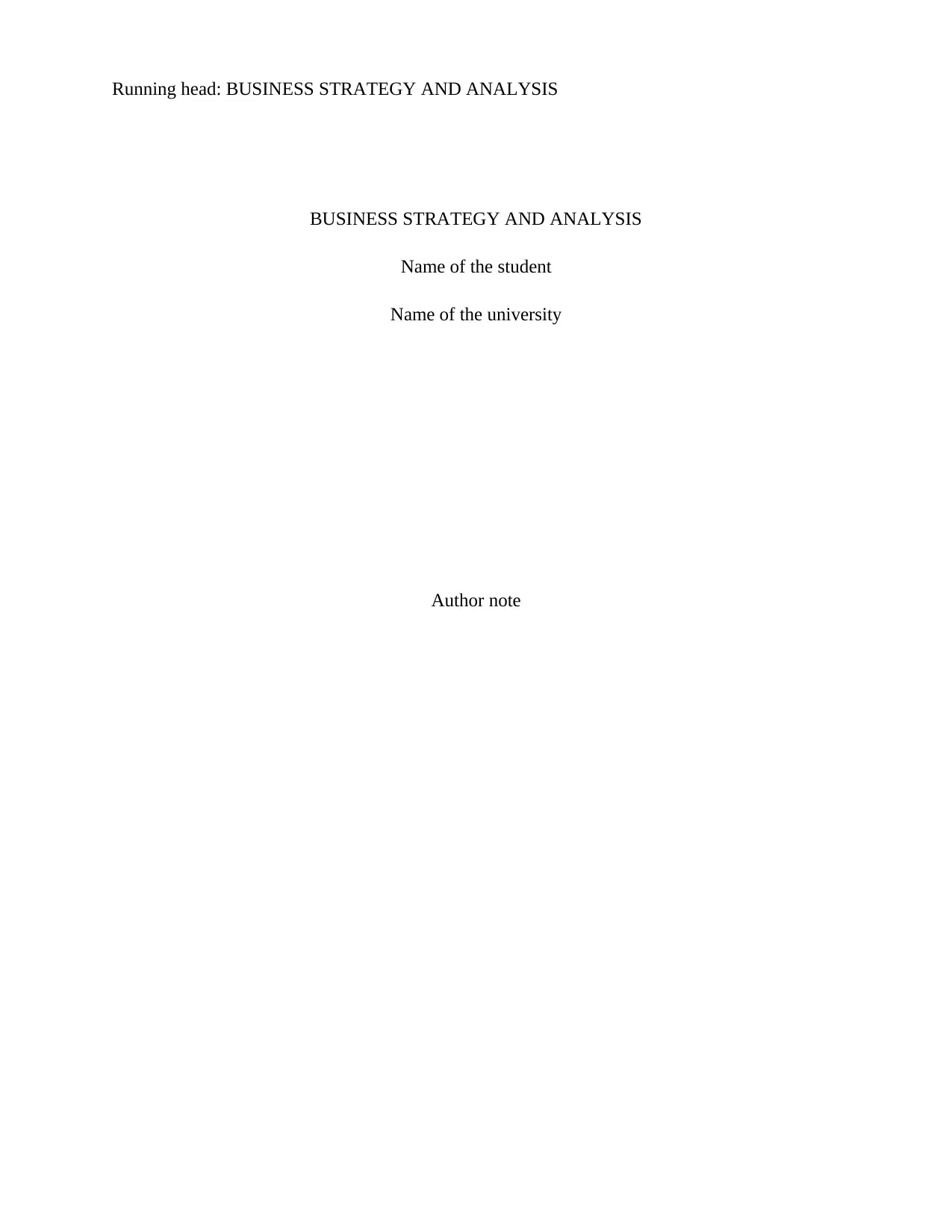
Running head: BUSINESS STRATEGY AND ANALYSIS
BUSINESS STRATEGY AND ANALYSIS
Name of the student
Name of the university
Author note
BUSINESS STRATEGY AND ANALYSIS
Name of the student
Name of the university
Author note
Paraphrase This Document
Need a fresh take? Get an instant paraphrase of this document with our AI Paraphraser
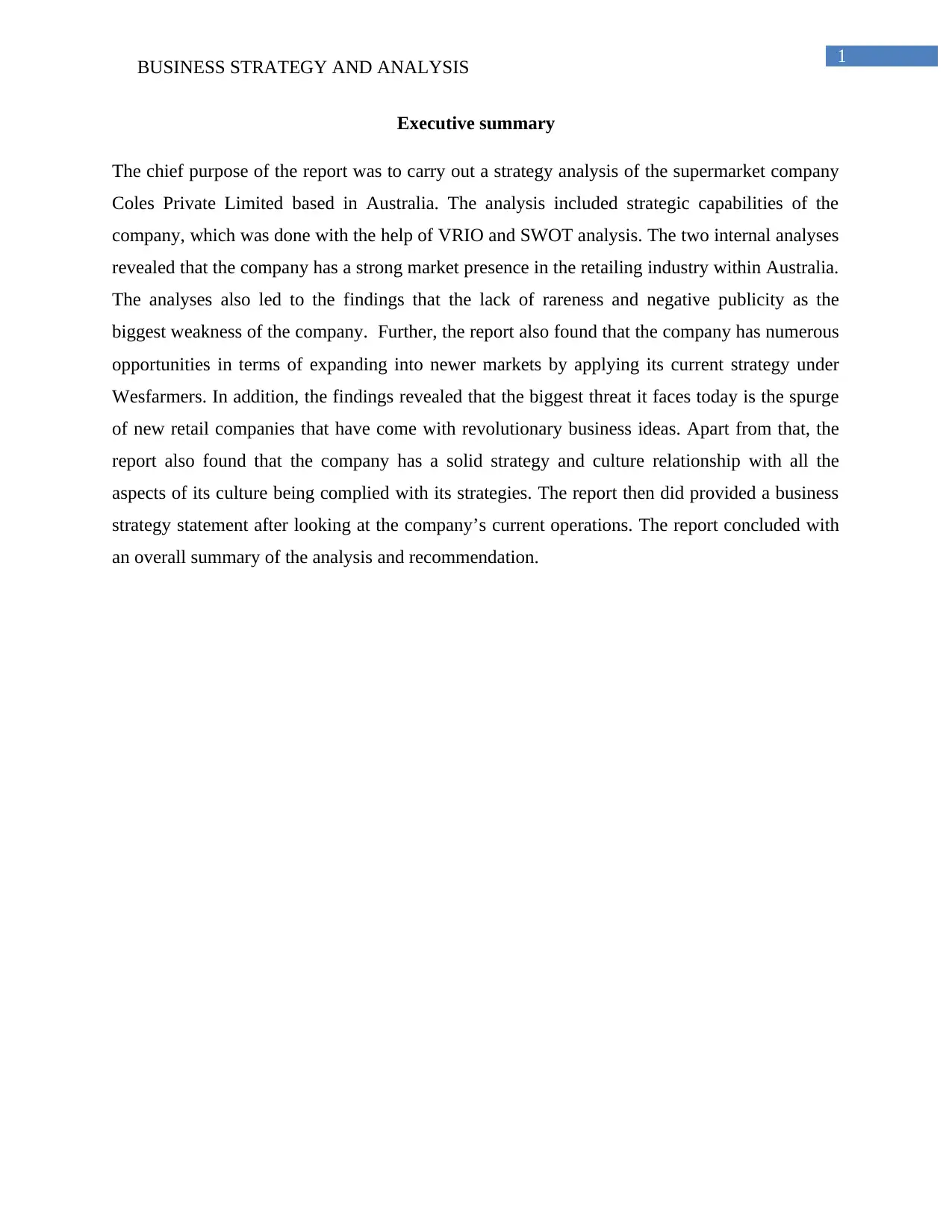
1
BUSINESS STRATEGY AND ANALYSIS
Executive summary
The chief purpose of the report was to carry out a strategy analysis of the supermarket company
Coles Private Limited based in Australia. The analysis included strategic capabilities of the
company, which was done with the help of VRIO and SWOT analysis. The two internal analyses
revealed that the company has a strong market presence in the retailing industry within Australia.
The analyses also led to the findings that the lack of rareness and negative publicity as the
biggest weakness of the company. Further, the report also found that the company has numerous
opportunities in terms of expanding into newer markets by applying its current strategy under
Wesfarmers. In addition, the findings revealed that the biggest threat it faces today is the spurge
of new retail companies that have come with revolutionary business ideas. Apart from that, the
report also found that the company has a solid strategy and culture relationship with all the
aspects of its culture being complied with its strategies. The report then did provided a business
strategy statement after looking at the company’s current operations. The report concluded with
an overall summary of the analysis and recommendation.
BUSINESS STRATEGY AND ANALYSIS
Executive summary
The chief purpose of the report was to carry out a strategy analysis of the supermarket company
Coles Private Limited based in Australia. The analysis included strategic capabilities of the
company, which was done with the help of VRIO and SWOT analysis. The two internal analyses
revealed that the company has a strong market presence in the retailing industry within Australia.
The analyses also led to the findings that the lack of rareness and negative publicity as the
biggest weakness of the company. Further, the report also found that the company has numerous
opportunities in terms of expanding into newer markets by applying its current strategy under
Wesfarmers. In addition, the findings revealed that the biggest threat it faces today is the spurge
of new retail companies that have come with revolutionary business ideas. Apart from that, the
report also found that the company has a solid strategy and culture relationship with all the
aspects of its culture being complied with its strategies. The report then did provided a business
strategy statement after looking at the company’s current operations. The report concluded with
an overall summary of the analysis and recommendation.
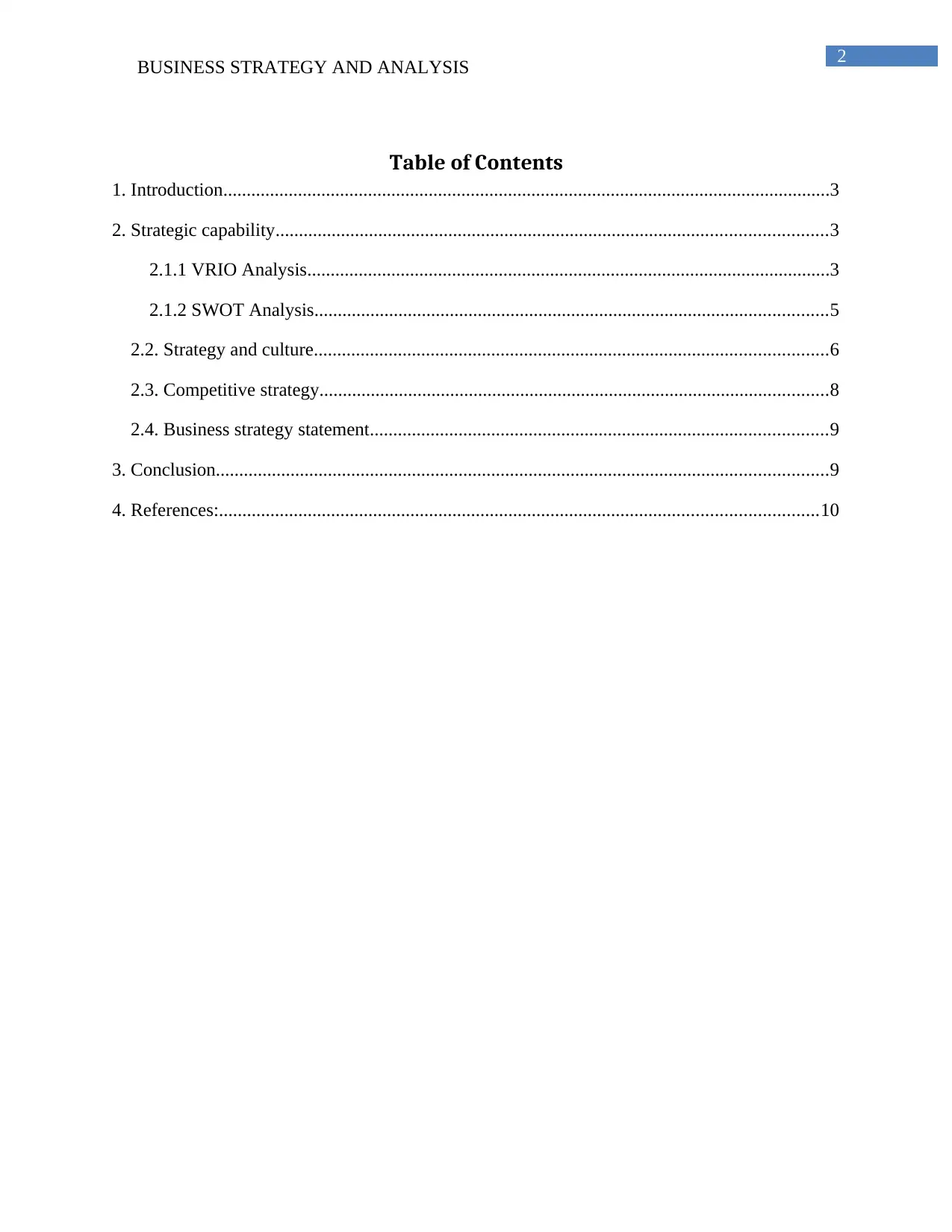
2
BUSINESS STRATEGY AND ANALYSIS
Table of Contents
1. Introduction..................................................................................................................................3
2. Strategic capability......................................................................................................................3
2.1.1 VRIO Analysis................................................................................................................3
2.1.2 SWOT Analysis..............................................................................................................5
2.2. Strategy and culture..............................................................................................................6
2.3. Competitive strategy.............................................................................................................8
2.4. Business strategy statement..................................................................................................9
3. Conclusion...................................................................................................................................9
4. References:................................................................................................................................10
BUSINESS STRATEGY AND ANALYSIS
Table of Contents
1. Introduction..................................................................................................................................3
2. Strategic capability......................................................................................................................3
2.1.1 VRIO Analysis................................................................................................................3
2.1.2 SWOT Analysis..............................................................................................................5
2.2. Strategy and culture..............................................................................................................6
2.3. Competitive strategy.............................................................................................................8
2.4. Business strategy statement..................................................................................................9
3. Conclusion...................................................................................................................................9
4. References:................................................................................................................................10
⊘ This is a preview!⊘
Do you want full access?
Subscribe today to unlock all pages.

Trusted by 1+ million students worldwide
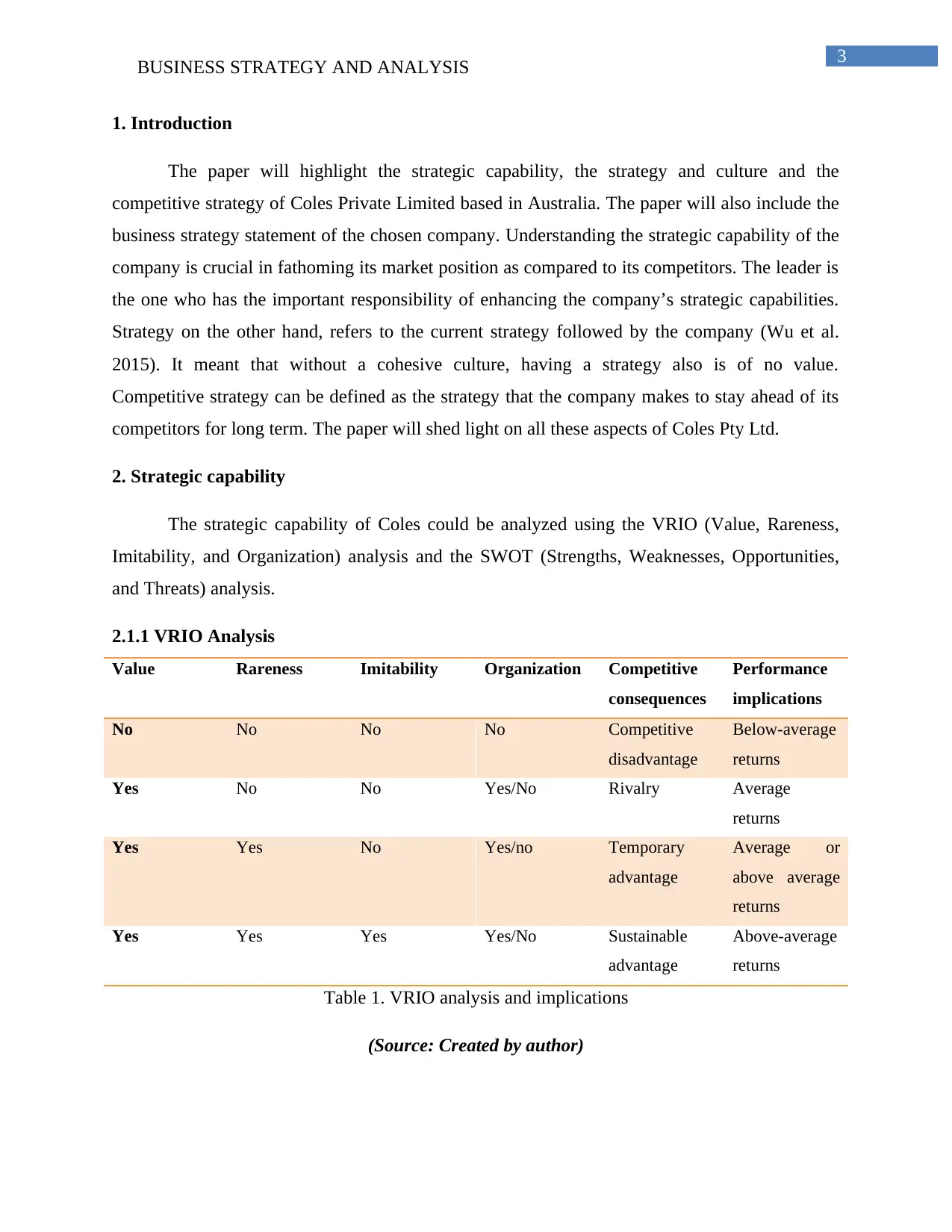
3
BUSINESS STRATEGY AND ANALYSIS
1. Introduction
The paper will highlight the strategic capability, the strategy and culture and the
competitive strategy of Coles Private Limited based in Australia. The paper will also include the
business strategy statement of the chosen company. Understanding the strategic capability of the
company is crucial in fathoming its market position as compared to its competitors. The leader is
the one who has the important responsibility of enhancing the company’s strategic capabilities.
Strategy on the other hand, refers to the current strategy followed by the company (Wu et al.
2015). It meant that without a cohesive culture, having a strategy also is of no value.
Competitive strategy can be defined as the strategy that the company makes to stay ahead of its
competitors for long term. The paper will shed light on all these aspects of Coles Pty Ltd.
2. Strategic capability
The strategic capability of Coles could be analyzed using the VRIO (Value, Rareness,
Imitability, and Organization) analysis and the SWOT (Strengths, Weaknesses, Opportunities,
and Threats) analysis.
2.1.1 VRIO Analysis
Value Rareness Imitability Organization Competitive
consequences
Performance
implications
No No No No Competitive
disadvantage
Below-average
returns
Yes No No Yes/No Rivalry Average
returns
Yes Yes No Yes/no Temporary
advantage
Average or
above average
returns
Yes Yes Yes Yes/No Sustainable
advantage
Above-average
returns
Table 1. VRIO analysis and implications
(Source: Created by author)
BUSINESS STRATEGY AND ANALYSIS
1. Introduction
The paper will highlight the strategic capability, the strategy and culture and the
competitive strategy of Coles Private Limited based in Australia. The paper will also include the
business strategy statement of the chosen company. Understanding the strategic capability of the
company is crucial in fathoming its market position as compared to its competitors. The leader is
the one who has the important responsibility of enhancing the company’s strategic capabilities.
Strategy on the other hand, refers to the current strategy followed by the company (Wu et al.
2015). It meant that without a cohesive culture, having a strategy also is of no value.
Competitive strategy can be defined as the strategy that the company makes to stay ahead of its
competitors for long term. The paper will shed light on all these aspects of Coles Pty Ltd.
2. Strategic capability
The strategic capability of Coles could be analyzed using the VRIO (Value, Rareness,
Imitability, and Organization) analysis and the SWOT (Strengths, Weaknesses, Opportunities,
and Threats) analysis.
2.1.1 VRIO Analysis
Value Rareness Imitability Organization Competitive
consequences
Performance
implications
No No No No Competitive
disadvantage
Below-average
returns
Yes No No Yes/No Rivalry Average
returns
Yes Yes No Yes/no Temporary
advantage
Average or
above average
returns
Yes Yes Yes Yes/No Sustainable
advantage
Above-average
returns
Table 1. VRIO analysis and implications
(Source: Created by author)
Paraphrase This Document
Need a fresh take? Get an instant paraphrase of this document with our AI Paraphraser
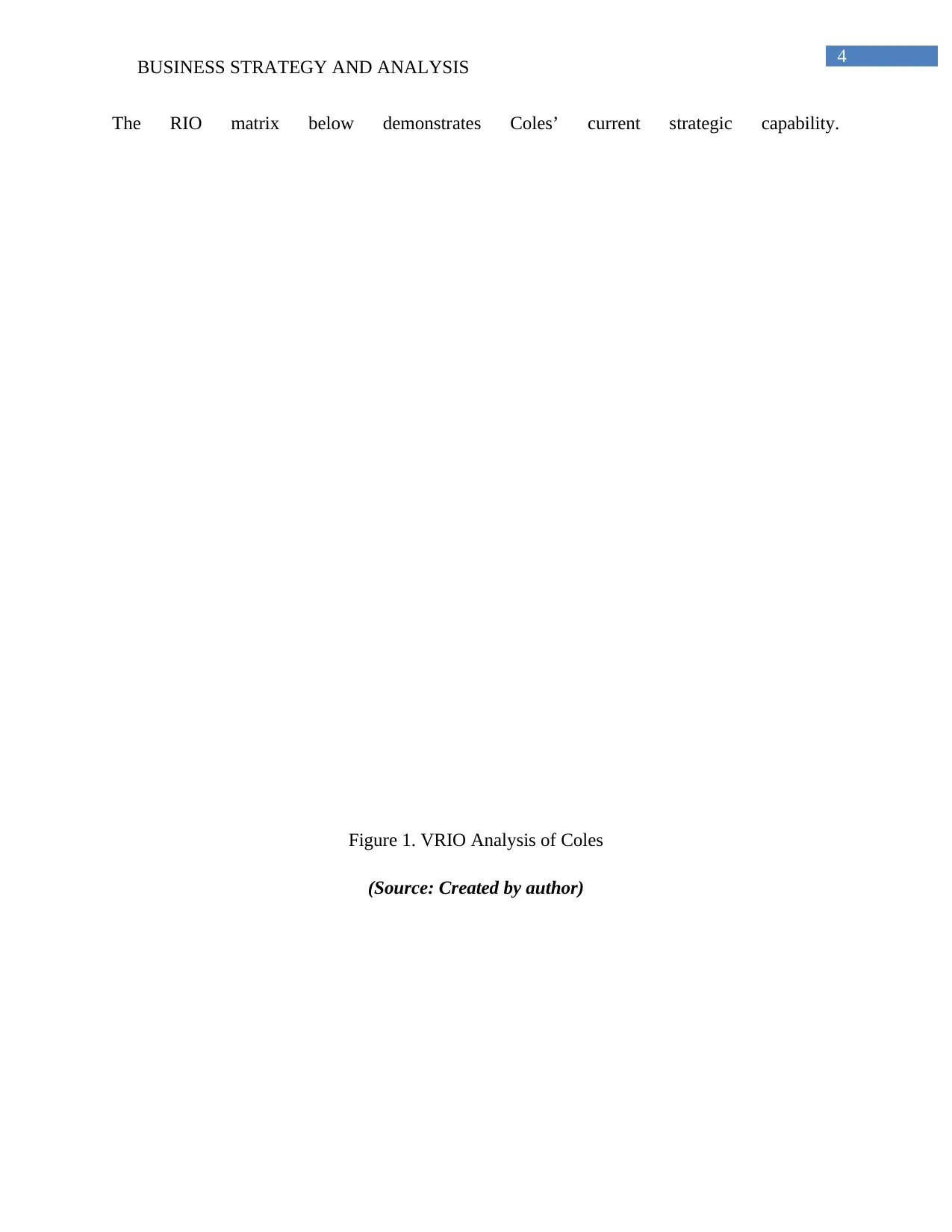
4
BUSINESS STRATEGY AND ANALYSIS
The RIO matrix below demonstrates Coles’ current strategic capability.
Figure 1. VRIO Analysis of Coles
(Source: Created by author)
BUSINESS STRATEGY AND ANALYSIS
The RIO matrix below demonstrates Coles’ current strategic capability.
Figure 1. VRIO Analysis of Coles
(Source: Created by author)
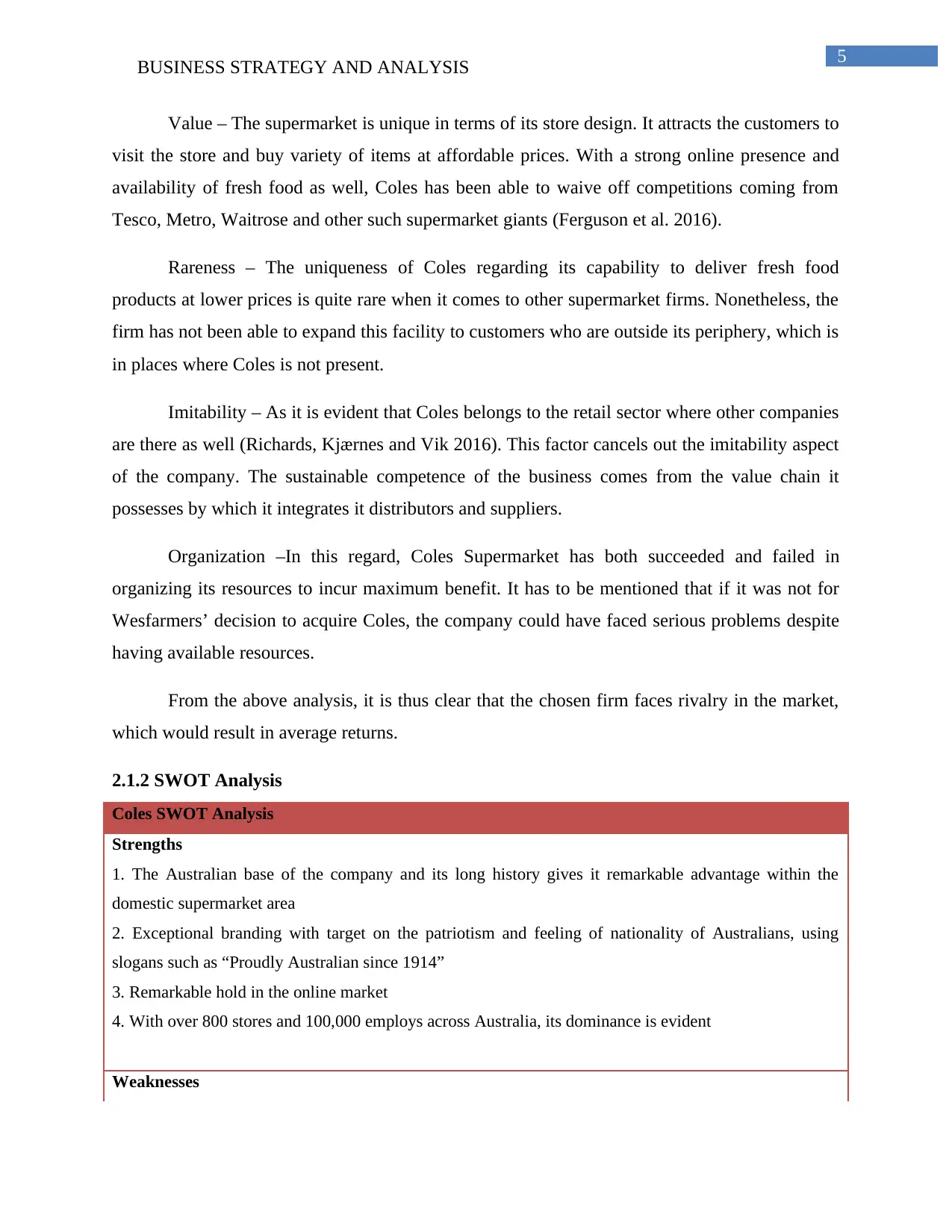
5
BUSINESS STRATEGY AND ANALYSIS
Value – The supermarket is unique in terms of its store design. It attracts the customers to
visit the store and buy variety of items at affordable prices. With a strong online presence and
availability of fresh food as well, Coles has been able to waive off competitions coming from
Tesco, Metro, Waitrose and other such supermarket giants (Ferguson et al. 2016).
Rareness – The uniqueness of Coles regarding its capability to deliver fresh food
products at lower prices is quite rare when it comes to other supermarket firms. Nonetheless, the
firm has not been able to expand this facility to customers who are outside its periphery, which is
in places where Coles is not present.
Imitability – As it is evident that Coles belongs to the retail sector where other companies
are there as well (Richards, Kjærnes and Vik 2016). This factor cancels out the imitability aspect
of the company. The sustainable competence of the business comes from the value chain it
possesses by which it integrates it distributors and suppliers.
Organization –In this regard, Coles Supermarket has both succeeded and failed in
organizing its resources to incur maximum benefit. It has to be mentioned that if it was not for
Wesfarmers’ decision to acquire Coles, the company could have faced serious problems despite
having available resources.
From the above analysis, it is thus clear that the chosen firm faces rivalry in the market,
which would result in average returns.
2.1.2 SWOT Analysis
Coles SWOT Analysis
Strengths
1. The Australian base of the company and its long history gives it remarkable advantage within the
domestic supermarket area
2. Exceptional branding with target on the patriotism and feeling of nationality of Australians, using
slogans such as “Proudly Australian since 1914”
3. Remarkable hold in the online market
4. With over 800 stores and 100,000 employs across Australia, its dominance is evident
Weaknesses
BUSINESS STRATEGY AND ANALYSIS
Value – The supermarket is unique in terms of its store design. It attracts the customers to
visit the store and buy variety of items at affordable prices. With a strong online presence and
availability of fresh food as well, Coles has been able to waive off competitions coming from
Tesco, Metro, Waitrose and other such supermarket giants (Ferguson et al. 2016).
Rareness – The uniqueness of Coles regarding its capability to deliver fresh food
products at lower prices is quite rare when it comes to other supermarket firms. Nonetheless, the
firm has not been able to expand this facility to customers who are outside its periphery, which is
in places where Coles is not present.
Imitability – As it is evident that Coles belongs to the retail sector where other companies
are there as well (Richards, Kjærnes and Vik 2016). This factor cancels out the imitability aspect
of the company. The sustainable competence of the business comes from the value chain it
possesses by which it integrates it distributors and suppliers.
Organization –In this regard, Coles Supermarket has both succeeded and failed in
organizing its resources to incur maximum benefit. It has to be mentioned that if it was not for
Wesfarmers’ decision to acquire Coles, the company could have faced serious problems despite
having available resources.
From the above analysis, it is thus clear that the chosen firm faces rivalry in the market,
which would result in average returns.
2.1.2 SWOT Analysis
Coles SWOT Analysis
Strengths
1. The Australian base of the company and its long history gives it remarkable advantage within the
domestic supermarket area
2. Exceptional branding with target on the patriotism and feeling of nationality of Australians, using
slogans such as “Proudly Australian since 1914”
3. Remarkable hold in the online market
4. With over 800 stores and 100,000 employs across Australia, its dominance is evident
Weaknesses
⊘ This is a preview!⊘
Do you want full access?
Subscribe today to unlock all pages.

Trusted by 1+ million students worldwide

6
BUSINESS STRATEGY AND ANALYSIS
1. Public sentiment marred by negative publicity caused due to involvement in controversy with
Australian suppliers
2. It functions on lower margins despite confronting stiff competition
Opportunities
1. It could grab better control of the supply chain to channel the manufactured product and yield profit at
numerous point
2. Expanding to other markets other than Australia could opportune the company with more options to
garner profit
3. Focusing on selling goods with private label could encourage growth in revenues
Threats
1. Rapid fall in food prices due to intense competition within the supermarket arena
2. Lack of clear and distinctive communication causing confusion amongst consumers regarding generic
brands
3. Presence of small and independent retailers rising as consumers prefer convenience
4. Retail market is rapidly evolving and new competitions are entering the market with innovative
business models
Table 2. SWOT Analysis of Coles
(Source: Created by author)
Significance – Analyzing the SWOT of Coles Pty Ltd reveals several aspects about its
strategic capability. The findings disclose the current position of the company within the retail
industry and the steps it needs to take. While weaknesses of the company are, marginal but might
influence other aspects as well. In terms of its strengths, Coles has a significant hold in the
Australian market however it must think of expanding to other markets (Sutton-Brady,
Kamvounias and Taylor 2015). This is because of the growing threat from emerging businesses
and business innovation. Opportunities like selling private label goods could help in removing
the threats such as confusion regarding generic goods amongst customers.
2.2. Strategy and culture
BUSINESS STRATEGY AND ANALYSIS
1. Public sentiment marred by negative publicity caused due to involvement in controversy with
Australian suppliers
2. It functions on lower margins despite confronting stiff competition
Opportunities
1. It could grab better control of the supply chain to channel the manufactured product and yield profit at
numerous point
2. Expanding to other markets other than Australia could opportune the company with more options to
garner profit
3. Focusing on selling goods with private label could encourage growth in revenues
Threats
1. Rapid fall in food prices due to intense competition within the supermarket arena
2. Lack of clear and distinctive communication causing confusion amongst consumers regarding generic
brands
3. Presence of small and independent retailers rising as consumers prefer convenience
4. Retail market is rapidly evolving and new competitions are entering the market with innovative
business models
Table 2. SWOT Analysis of Coles
(Source: Created by author)
Significance – Analyzing the SWOT of Coles Pty Ltd reveals several aspects about its
strategic capability. The findings disclose the current position of the company within the retail
industry and the steps it needs to take. While weaknesses of the company are, marginal but might
influence other aspects as well. In terms of its strengths, Coles has a significant hold in the
Australian market however it must think of expanding to other markets (Sutton-Brady,
Kamvounias and Taylor 2015). This is because of the growing threat from emerging businesses
and business innovation. Opportunities like selling private label goods could help in removing
the threats such as confusion regarding generic goods amongst customers.
2.2. Strategy and culture
Paraphrase This Document
Need a fresh take? Get an instant paraphrase of this document with our AI Paraphraser

7
BUSINESS STRATEGY AND ANALYSIS
Coles has adopted an aggressive strategy related to marketing that helps it to raise its
brand value and visibility of consumers. One of the most effective strategies of the company was
to target the patriotism feeling of the customers by promoting the “Australianness” of its brand.
Further, the firm employs the strategy to sell items that are healthy and hygienic thus targeting
the health conscious customers. It also focuses on promotional strategies that continue to change
with the changing market environment. Coles Organic and Coles Simply Less are two strategies
that have really helped the company flourish in the face of stiff competition (Coles.com.au
2018).
Culture of the company includes the stories associated with it, the routines and rituals,
organizational structure and control systems. At Coles, the organizational culture is based on five
fundamental ideals. These include, simplicity, inspiring customers, being bold, work as one team
and have passionate care for everyone (McCarthy 2015). In addition to that, Coles encourages a
culture where new ideas are always welcomed and the employees are allowed to participate in
the decision-making process. The prime motive of the company is to sell with passion and
personality, which also reflects its culture.
Image 1. The Culture Web of Coles
(Source: Colescareers.com.au 2018)
A look at the strategies employed by Coles and the culture it possesses, it could be
observed that both have an intrinsic relationship. In the above picture, it is clearly visible that the
strategies of Coles align with its culture. Inspiring customers by building great careers, being
bold by transforming the liquor industry, simplifying ways by keeping the simplicity of services
intact; working as one team with a sharing network and caring passionately by providing value to
BUSINESS STRATEGY AND ANALYSIS
Coles has adopted an aggressive strategy related to marketing that helps it to raise its
brand value and visibility of consumers. One of the most effective strategies of the company was
to target the patriotism feeling of the customers by promoting the “Australianness” of its brand.
Further, the firm employs the strategy to sell items that are healthy and hygienic thus targeting
the health conscious customers. It also focuses on promotional strategies that continue to change
with the changing market environment. Coles Organic and Coles Simply Less are two strategies
that have really helped the company flourish in the face of stiff competition (Coles.com.au
2018).
Culture of the company includes the stories associated with it, the routines and rituals,
organizational structure and control systems. At Coles, the organizational culture is based on five
fundamental ideals. These include, simplicity, inspiring customers, being bold, work as one team
and have passionate care for everyone (McCarthy 2015). In addition to that, Coles encourages a
culture where new ideas are always welcomed and the employees are allowed to participate in
the decision-making process. The prime motive of the company is to sell with passion and
personality, which also reflects its culture.
Image 1. The Culture Web of Coles
(Source: Colescareers.com.au 2018)
A look at the strategies employed by Coles and the culture it possesses, it could be
observed that both have an intrinsic relationship. In the above picture, it is clearly visible that the
strategies of Coles align with its culture. Inspiring customers by building great careers, being
bold by transforming the liquor industry, simplifying ways by keeping the simplicity of services
intact; working as one team with a sharing network and caring passionately by providing value to
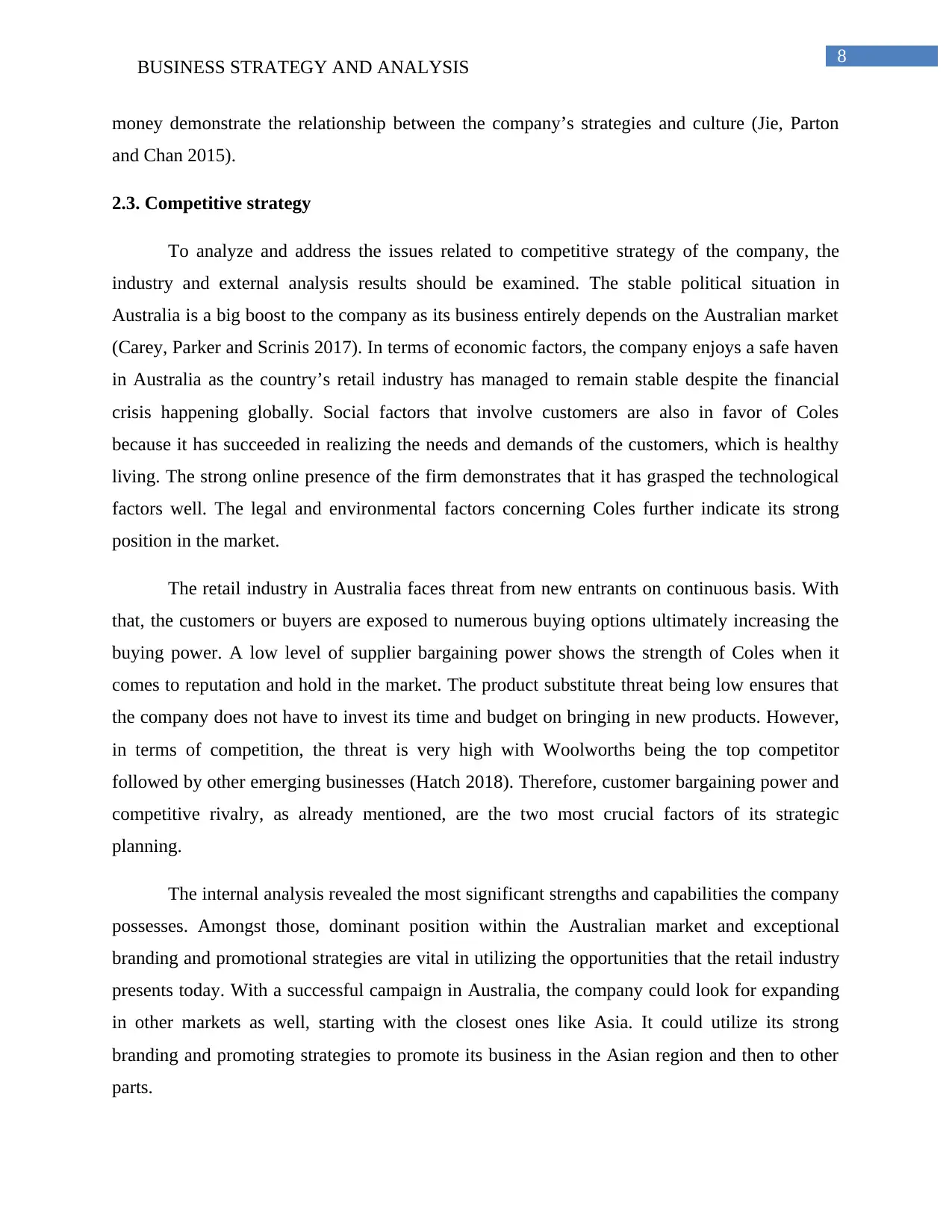
8
BUSINESS STRATEGY AND ANALYSIS
money demonstrate the relationship between the company’s strategies and culture (Jie, Parton
and Chan 2015).
2.3. Competitive strategy
To analyze and address the issues related to competitive strategy of the company, the
industry and external analysis results should be examined. The stable political situation in
Australia is a big boost to the company as its business entirely depends on the Australian market
(Carey, Parker and Scrinis 2017). In terms of economic factors, the company enjoys a safe haven
in Australia as the country’s retail industry has managed to remain stable despite the financial
crisis happening globally. Social factors that involve customers are also in favor of Coles
because it has succeeded in realizing the needs and demands of the customers, which is healthy
living. The strong online presence of the firm demonstrates that it has grasped the technological
factors well. The legal and environmental factors concerning Coles further indicate its strong
position in the market.
The retail industry in Australia faces threat from new entrants on continuous basis. With
that, the customers or buyers are exposed to numerous buying options ultimately increasing the
buying power. A low level of supplier bargaining power shows the strength of Coles when it
comes to reputation and hold in the market. The product substitute threat being low ensures that
the company does not have to invest its time and budget on bringing in new products. However,
in terms of competition, the threat is very high with Woolworths being the top competitor
followed by other emerging businesses (Hatch 2018). Therefore, customer bargaining power and
competitive rivalry, as already mentioned, are the two most crucial factors of its strategic
planning.
The internal analysis revealed the most significant strengths and capabilities the company
possesses. Amongst those, dominant position within the Australian market and exceptional
branding and promotional strategies are vital in utilizing the opportunities that the retail industry
presents today. With a successful campaign in Australia, the company could look for expanding
in other markets as well, starting with the closest ones like Asia. It could utilize its strong
branding and promoting strategies to promote its business in the Asian region and then to other
parts.
BUSINESS STRATEGY AND ANALYSIS
money demonstrate the relationship between the company’s strategies and culture (Jie, Parton
and Chan 2015).
2.3. Competitive strategy
To analyze and address the issues related to competitive strategy of the company, the
industry and external analysis results should be examined. The stable political situation in
Australia is a big boost to the company as its business entirely depends on the Australian market
(Carey, Parker and Scrinis 2017). In terms of economic factors, the company enjoys a safe haven
in Australia as the country’s retail industry has managed to remain stable despite the financial
crisis happening globally. Social factors that involve customers are also in favor of Coles
because it has succeeded in realizing the needs and demands of the customers, which is healthy
living. The strong online presence of the firm demonstrates that it has grasped the technological
factors well. The legal and environmental factors concerning Coles further indicate its strong
position in the market.
The retail industry in Australia faces threat from new entrants on continuous basis. With
that, the customers or buyers are exposed to numerous buying options ultimately increasing the
buying power. A low level of supplier bargaining power shows the strength of Coles when it
comes to reputation and hold in the market. The product substitute threat being low ensures that
the company does not have to invest its time and budget on bringing in new products. However,
in terms of competition, the threat is very high with Woolworths being the top competitor
followed by other emerging businesses (Hatch 2018). Therefore, customer bargaining power and
competitive rivalry, as already mentioned, are the two most crucial factors of its strategic
planning.
The internal analysis revealed the most significant strengths and capabilities the company
possesses. Amongst those, dominant position within the Australian market and exceptional
branding and promotional strategies are vital in utilizing the opportunities that the retail industry
presents today. With a successful campaign in Australia, the company could look for expanding
in other markets as well, starting with the closest ones like Asia. It could utilize its strong
branding and promoting strategies to promote its business in the Asian region and then to other
parts.
⊘ This is a preview!⊘
Do you want full access?
Subscribe today to unlock all pages.

Trusted by 1+ million students worldwide
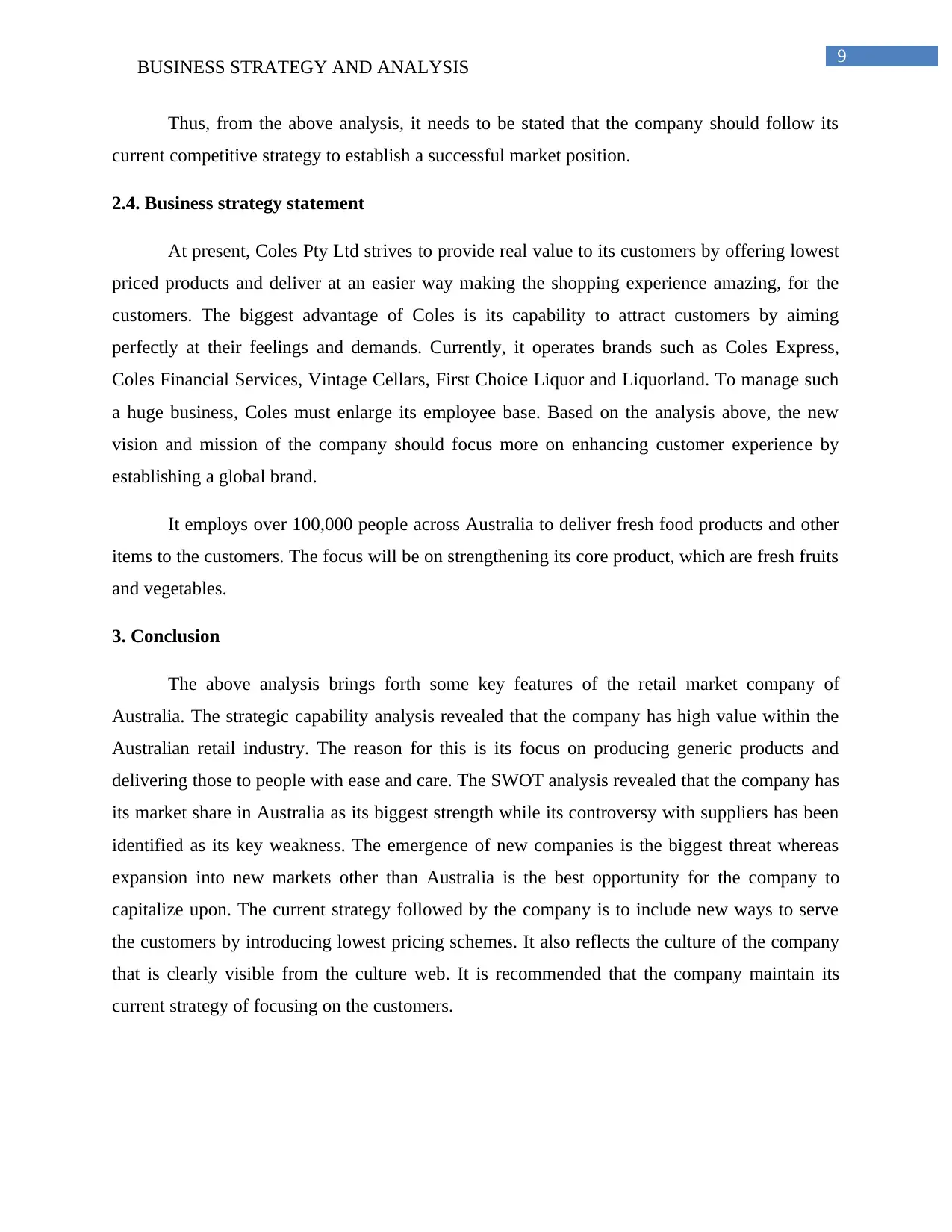
9
BUSINESS STRATEGY AND ANALYSIS
Thus, from the above analysis, it needs to be stated that the company should follow its
current competitive strategy to establish a successful market position.
2.4. Business strategy statement
At present, Coles Pty Ltd strives to provide real value to its customers by offering lowest
priced products and deliver at an easier way making the shopping experience amazing, for the
customers. The biggest advantage of Coles is its capability to attract customers by aiming
perfectly at their feelings and demands. Currently, it operates brands such as Coles Express,
Coles Financial Services, Vintage Cellars, First Choice Liquor and Liquorland. To manage such
a huge business, Coles must enlarge its employee base. Based on the analysis above, the new
vision and mission of the company should focus more on enhancing customer experience by
establishing a global brand.
It employs over 100,000 people across Australia to deliver fresh food products and other
items to the customers. The focus will be on strengthening its core product, which are fresh fruits
and vegetables.
3. Conclusion
The above analysis brings forth some key features of the retail market company of
Australia. The strategic capability analysis revealed that the company has high value within the
Australian retail industry. The reason for this is its focus on producing generic products and
delivering those to people with ease and care. The SWOT analysis revealed that the company has
its market share in Australia as its biggest strength while its controversy with suppliers has been
identified as its key weakness. The emergence of new companies is the biggest threat whereas
expansion into new markets other than Australia is the best opportunity for the company to
capitalize upon. The current strategy followed by the company is to include new ways to serve
the customers by introducing lowest pricing schemes. It also reflects the culture of the company
that is clearly visible from the culture web. It is recommended that the company maintain its
current strategy of focusing on the customers.
BUSINESS STRATEGY AND ANALYSIS
Thus, from the above analysis, it needs to be stated that the company should follow its
current competitive strategy to establish a successful market position.
2.4. Business strategy statement
At present, Coles Pty Ltd strives to provide real value to its customers by offering lowest
priced products and deliver at an easier way making the shopping experience amazing, for the
customers. The biggest advantage of Coles is its capability to attract customers by aiming
perfectly at their feelings and demands. Currently, it operates brands such as Coles Express,
Coles Financial Services, Vintage Cellars, First Choice Liquor and Liquorland. To manage such
a huge business, Coles must enlarge its employee base. Based on the analysis above, the new
vision and mission of the company should focus more on enhancing customer experience by
establishing a global brand.
It employs over 100,000 people across Australia to deliver fresh food products and other
items to the customers. The focus will be on strengthening its core product, which are fresh fruits
and vegetables.
3. Conclusion
The above analysis brings forth some key features of the retail market company of
Australia. The strategic capability analysis revealed that the company has high value within the
Australian retail industry. The reason for this is its focus on producing generic products and
delivering those to people with ease and care. The SWOT analysis revealed that the company has
its market share in Australia as its biggest strength while its controversy with suppliers has been
identified as its key weakness. The emergence of new companies is the biggest threat whereas
expansion into new markets other than Australia is the best opportunity for the company to
capitalize upon. The current strategy followed by the company is to include new ways to serve
the customers by introducing lowest pricing schemes. It also reflects the culture of the company
that is clearly visible from the culture web. It is recommended that the company maintain its
current strategy of focusing on the customers.
Paraphrase This Document
Need a fresh take? Get an instant paraphrase of this document with our AI Paraphraser

10
BUSINESS STRATEGY AND ANALYSIS
4. References:
Carey, R., Parker, C. and Scrinis, G., 2017. Capturing the meaning of “free range”: The contest
between producers, supermarkets and consumers for the higher welfare egg label in
Australia. Journal of Rural Studies, 54, pp.266-275.
Coles.com.au 2018. Our History. [online] Coles.com.au. Available at:
https://www.coles.com.au/about-coles/centenary [Accessed 14 Sep. 2018].
Colescareers.com.au 2018. Our strategy, values and brands. [online] Colescareers.com.au.
Available at: https://www.colescareers.com.au/about-us/our-brands [Accessed 14 Sep. 2018].
Ferguson, M., O'dea, K., Chatfield, M., Moodie, M., Altman, J. and Brimblecombe, J., 2016. The
comparative cost of food and beverages at remote Indigenous communities, Northern Territory,
Australia. Australian and New Zealand journal of public health, 40(S1), pp.S21-S26.
Hatch, P. 2018. 'Putting out fires': Coles' new plan to beat Woolies. [online] The Sydney
Morning Herald. Available at: https://www.smh.com.au/business/companies/putting-out-fires-
coles-new-plan-to-beat-woolies-20180306-p4z33i.html [Accessed 14 Sep. 2018].
Jie, F., Parton, K. and Chan, C., 2015. Australian beef supply chain integration: case studies of
the two largest Australian supermarkets. International Journal of Supply Chain and Operations
Resilience, 1(2), pp.121-138.
McCarthy, B.L., 2015. Trends in organic and green food consumption in China: Opportunities
and challenges for regional Australian exporters. Journal of Economic & Social Policy, 17(1),
p.6.
Richards, C., Kjærnes, U. and Vik, J., 2016. Food security in welfare capitalism: Comparing
social entitlements to food in Australia and Norway. Journal of rural studies, 43, pp.61-70.
Sutton-Brady, C., Kamvounias, P. and Taylor, T., 2015. A model of supplier–retailer power
asymmetry in the Australian retail industry. Industrial marketing management, 51, pp.122-130.
Wu, J.H., Neal, B., Trevena, H., Crino, M., Stuart-Smith, W., Faulkner-Hogg, K., Louie, J.C.Y.
and Dunford, E., 2015. Are gluten-free foods healthier than non-gluten-free foods? An
BUSINESS STRATEGY AND ANALYSIS
4. References:
Carey, R., Parker, C. and Scrinis, G., 2017. Capturing the meaning of “free range”: The contest
between producers, supermarkets and consumers for the higher welfare egg label in
Australia. Journal of Rural Studies, 54, pp.266-275.
Coles.com.au 2018. Our History. [online] Coles.com.au. Available at:
https://www.coles.com.au/about-coles/centenary [Accessed 14 Sep. 2018].
Colescareers.com.au 2018. Our strategy, values and brands. [online] Colescareers.com.au.
Available at: https://www.colescareers.com.au/about-us/our-brands [Accessed 14 Sep. 2018].
Ferguson, M., O'dea, K., Chatfield, M., Moodie, M., Altman, J. and Brimblecombe, J., 2016. The
comparative cost of food and beverages at remote Indigenous communities, Northern Territory,
Australia. Australian and New Zealand journal of public health, 40(S1), pp.S21-S26.
Hatch, P. 2018. 'Putting out fires': Coles' new plan to beat Woolies. [online] The Sydney
Morning Herald. Available at: https://www.smh.com.au/business/companies/putting-out-fires-
coles-new-plan-to-beat-woolies-20180306-p4z33i.html [Accessed 14 Sep. 2018].
Jie, F., Parton, K. and Chan, C., 2015. Australian beef supply chain integration: case studies of
the two largest Australian supermarkets. International Journal of Supply Chain and Operations
Resilience, 1(2), pp.121-138.
McCarthy, B.L., 2015. Trends in organic and green food consumption in China: Opportunities
and challenges for regional Australian exporters. Journal of Economic & Social Policy, 17(1),
p.6.
Richards, C., Kjærnes, U. and Vik, J., 2016. Food security in welfare capitalism: Comparing
social entitlements to food in Australia and Norway. Journal of rural studies, 43, pp.61-70.
Sutton-Brady, C., Kamvounias, P. and Taylor, T., 2015. A model of supplier–retailer power
asymmetry in the Australian retail industry. Industrial marketing management, 51, pp.122-130.
Wu, J.H., Neal, B., Trevena, H., Crino, M., Stuart-Smith, W., Faulkner-Hogg, K., Louie, J.C.Y.
and Dunford, E., 2015. Are gluten-free foods healthier than non-gluten-free foods? An
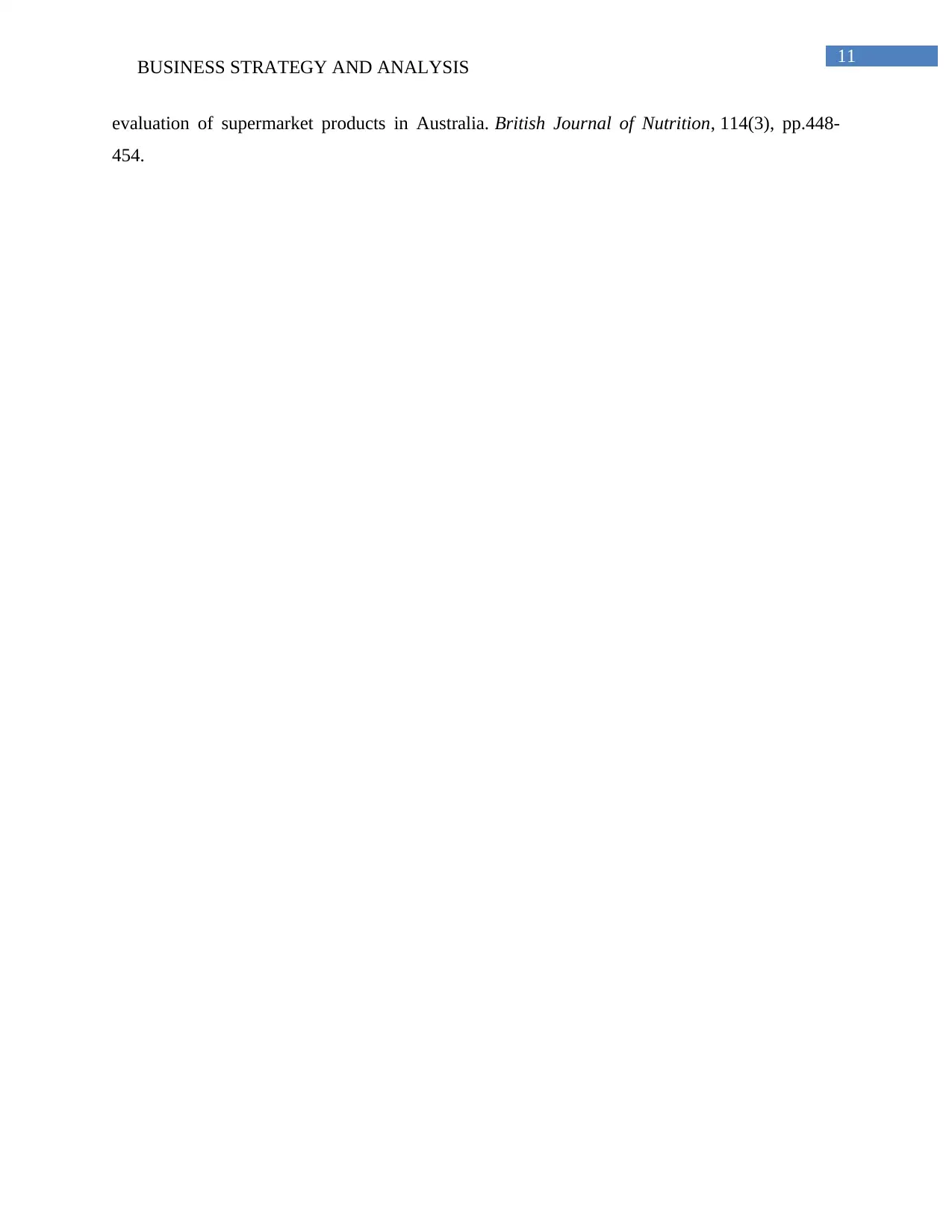
11
BUSINESS STRATEGY AND ANALYSIS
evaluation of supermarket products in Australia. British Journal of Nutrition, 114(3), pp.448-
454.
BUSINESS STRATEGY AND ANALYSIS
evaluation of supermarket products in Australia. British Journal of Nutrition, 114(3), pp.448-
454.
⊘ This is a preview!⊘
Do you want full access?
Subscribe today to unlock all pages.

Trusted by 1+ million students worldwide
1 out of 12
Related Documents
Your All-in-One AI-Powered Toolkit for Academic Success.
+13062052269
info@desklib.com
Available 24*7 on WhatsApp / Email
![[object Object]](/_next/static/media/star-bottom.7253800d.svg)
Unlock your academic potential
Copyright © 2020–2025 A2Z Services. All Rights Reserved. Developed and managed by ZUCOL.





